The first generation biofuel market is estimated to be valued at USD 173.5 billion in 2025 and is projected to reach USD 344.6 billion by 2035, registering a compound annual growth rate (CAGR) of 7.1% over the forecast period. Early growth is influenced by widespread utilization of conventional feedstocks such as corn, sugarcane, and vegetable oils, supported by established production infrastructure and distribution networks. Mid-period expansion is driven by policy incentives, carbon reduction targets, and growing consumer and corporate demand for alternative fuels, which encourages higher production capacities and technological advancements in refining and processing. Later years reflect gradual saturation of mature feedstock regions, prompting diversification strategies and exploration of second-generation alternatives alongside traditional biofuels.
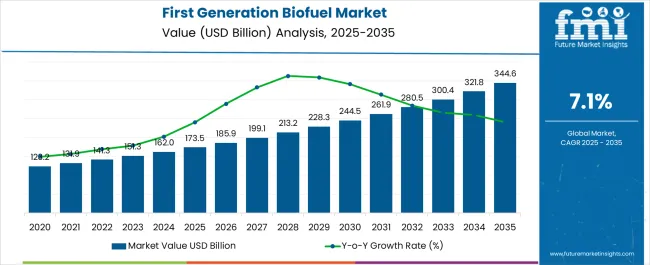
| Metric | Value |
|---|---|
| First Generation Biofuel Market Estimated Value in (2025 E) | USD 173.5 billion |
| First Generation Biofuel Market Forecast Value in (2035 F) | USD 344.6 billion |
| Forecast CAGR (2025 to 2035) | 7.1% |
The first generation biofuel market is gaining momentum as governments and industries accelerate efforts to reduce reliance on fossil fuels and transition toward cleaner energy sources. Produced primarily from food based feedstocks such as corn, sugarcane, and vegetable oils, first generation biofuels have become integral to national energy security strategies and carbon emission reduction targets. Policy incentives including blending mandates, tax credits, and investment in biofuel infrastructure have supported widespread production and consumption.
Rising crude oil prices and the increasing need for energy diversification are further driving adoption. The demand is especially strong in the transportation sector where biofuels serve as viable drop in alternatives to conventional fuels.
While debates around food versus fuel continue, advancements in feedstock efficiency and integrated supply chain practices are helping to improve sustainability performance. The market outlook remains positive as regulatory frameworks evolve and energy producers scale operations to meet future fuel demand in an environmentally responsible manner.
The first generation biofuel market is segmented by fuel type, feedstock, application, and geographic regions. By fuel type, the first-generation biofuel market is divided into Biodiesel and Ethanol. In terms of feedstock, the first-generation biofuel market is classified into Coarse Grain, Sugar Crop, Vegetable Oil, and Others. Based on the application, the first-generation biofuel market is segmented into Transportation, Aviation, and Others. Regionally, the first generation biofuel industry is classified into North America, Latin America, Western Europe, Eastern Europe, Balkan & Baltic Countries, Russia & Belarus, Central Asia, East Asia, South Asia & Pacific, and the Middle East & Africa.
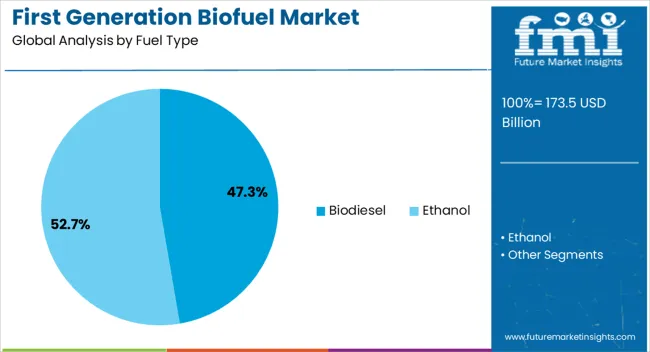
The biodiesel segment is projected to contribute 47.30% of the total market revenue by 2025 within the fuel type category, establishing it as the leading segment. This growth is supported by its compatibility with existing diesel engines, lower greenhouse gas emissions, and favorable energy balance.
Biodiesel is derived from widely available raw materials including vegetable oils and animal fats, making it accessible for both large scale and decentralized production. Its biodegradable nature and ability to reduce particulate emissions have made it a preferred choice in emission-sensitive regions.
With government mandates and fuel blending programs expanding, biodiesel continues to gain traction as a sustainable fuel alternative. Its ease of integration into the current fuel infrastructure further reinforces its leadership in the market.
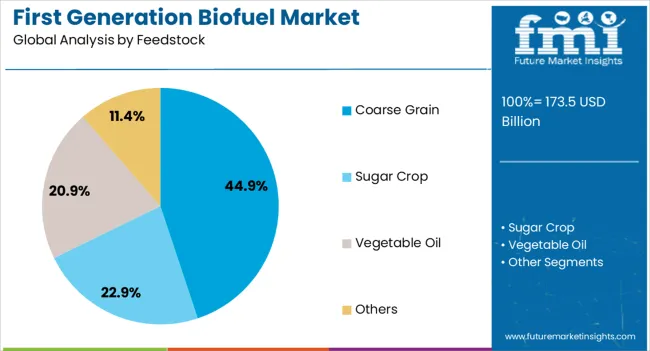
The coarse grain segment is expected to account for 44.90% of the market by 2025 under the feedstock category, making it the most dominant input material. Grains such as corn and sorghum are readily available and widely cultivated, providing a reliable and scalable source for ethanol production.
Technological improvements in grain processing and fermentation efficiency have enhanced yield and reduced production costs. Moreover, existing agricultural infrastructure and subsidies for grain production contribute to the segment’s competitiveness.
As nations prioritize energy independence and rural development, the role of coarse grains in the biofuel supply chain is expected to remain strong, supporting their continued prominence in the market.
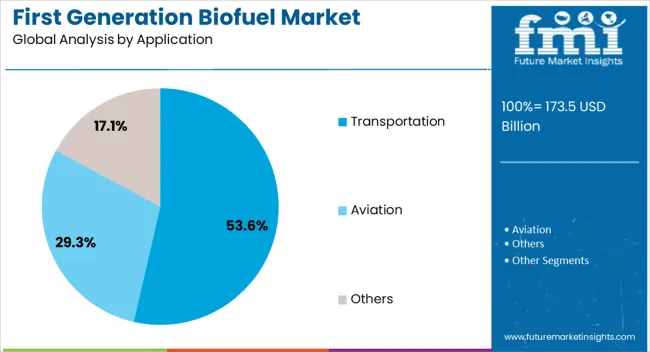
The transportation segment is projected to represent 53.60% of total revenue by 2025 in the application category, positioning it as the largest end use sector. This dominance is driven by the urgent need to decarbonize road transport and comply with international climate commitments.
Biofuels are increasingly being adopted in public transit, freight, and private vehicle fleets as a cleaner substitute for petroleum based fuels. The ability to blend seamlessly with conventional fuels without requiring major engine modifications has accelerated their use.
National energy strategies and carbon reduction policies have reinforced demand for biofuels in transport applications. With ongoing infrastructure development and increasing consumer acceptance, transportation is expected to remain the primary driver of market expansion for first generation biofuels.
The first-generation biofuel market is driven by government policies, with opportunities arising in alternative transport sectors. However, challenges related to food security, production costs, and environmental impact must be addressed for long-term growth.
The first-generation biofuel market is primarily driven by government mandates and policies promoting the use of renewable energy sources. Rising demand for alternative fuels to reduce dependence on fossil fuels has increased the adoption of first-generation biofuels, particularly ethanol and biodiesel. The agricultural sector's capacity to provide abundant raw materials, such as corn, soybeans, and sugarcane, has further supported market growth. In regions like the USA and Brazil, government incentives and tax credits for biofuel production have significantly boosted the industry. Additionally, the automotive sector’s push for cleaner fuels to comply with environmental regulations has accelerated the demand for biofuels, reinforcing their market presence globally.
Despite its growth, the first-generation biofuel market faces significant challenges, including competition with food production. As biofuels use edible crops, concerns about food prices and supply shortages have raised ethical issues and hindered market expansion. Environmental concerns over land use for biofuel crops and the impact on biodiversity also present hurdles. The high cost of biofuel production, particularly from food-based feedstocks, poses a challenge to scaling the industry without significant government subsidies. These challenges have led to growing calls for the development of second-generation biofuels, derived from non-food sources, which are seen as more sustainable alternatives.
There are notable opportunities in expanding biofuel usage in sectors such as aviation, marine transport, and heavy industry. The growing interest in sustainable aviation fuel (SAF) presents an emerging market for ethanol and biodiesel. First-generation biofuels are also being integrated into hybrid vehicle systems to optimize fuel efficiency. Increasing global trade in biofuels and growing consumption in developing economies with rising vehicle ownership will further expand market reach. Improvements in agricultural yields and biofuel production efficiency, driven by investment in farming and manufacturing, offer opportunities to reduce costs and improve overall market competitiveness.
The future outlook for first-generation biofuels is marked by steady growth, although at a slower pace compared to emerging biofuel technologies. With global pushbacks against food-based biofuels, future market dynamics may shift toward advanced biofuels, like algae-based or waste-derived alternatives. However, first-generation biofuels will still hold a significant share of the market, particularly in countries with well-established biofuel infrastructure. As more nations set ambitious renewable energy targets, first-generation biofuels will likely continue playing a key role in meeting short-term energy needs while bridging the gap toward more advanced biofuel solutions.
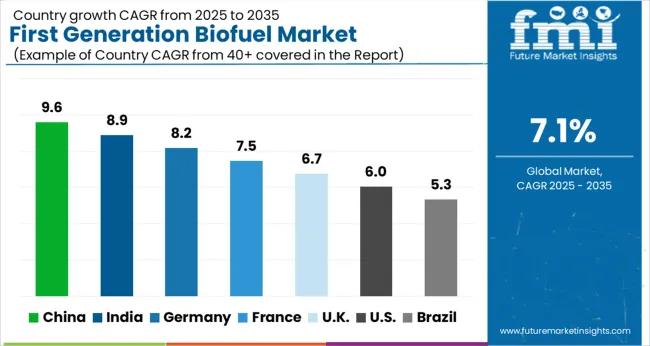
| Countries | CAGR |
|---|---|
| China | 9.6% |
| India | 8.9% |
| Germany | 8.2% |
| France | 7.5% |
| UK | 6.7% |
| USA | 6.0% |
| Brazil | 5.3% |
The first-generation biofuel market is projected to grow globally at a CAGR of 7.1% from 2025 to 2035, driven by increasing adoption of renewable energy and government mandates. China leads with a CAGR of 9.6%, supported by its large-scale biofuel production capacity and strong policy incentives to reduce reliance on fossil fuels. India follows at 8.9%, with growing biofuel infrastructure and government-backed renewable energy goals. France shows 7.5% growth, driven by EU biofuel regulations and the increasing use of ethanol in the automotive sector. The UK achieves 6.7% growth, bolstered by expanding biofuel production and use in both transportation and heating sectors. The USA posts a CAGR of 6.0%, with strong government support and rising ethanol consumption in the transportation industry. This research covers over 40 countries, with these markets serving as benchmarks for biofuel production strategies, government regulations, and energy diversification.
China is projected to grow at a CAGR of 9.6% during 2025–2035, well above the global 7.1% pace. The earlier period, 2020–2024, is estimated at 8.0%, driven by the country's large-scale biofuel production capacity and government policies supporting renewable energy. Higher growth in the next horizon is expected from increasing ethanol demand in transportation fuels, higher biofuel blending mandates, and greater investment in biofuel infrastructure. The market will benefit from China's agricultural base, which provides a steady supply of raw materials for biofuel production, including crops like corn and sugarcane. Government-backed incentives and biofuel mandates will further boost the market, with stronger support for ethanol and biodiesel in industrial and transport sectors.
India is expected to post a CAGR of 8.9% during 2025–2035, well above the global average. The 2020–2024 phase is projected to grow at a CAGR of 8.1%, driven by the country's increasing biofuel infrastructure and government initiatives aimed at reducing fossil fuel dependence. The rise in ethanol production from domestic crops such as sugarcane and corn has boosted market growth. The higher growth rate for 2025–2035 will be supported by India’s growing demand for clean energy solutions, particularly ethanol for transportation. The push for renewable energy, along with improved supply chains and biofuel production capabilities, will sustain long-term growth.
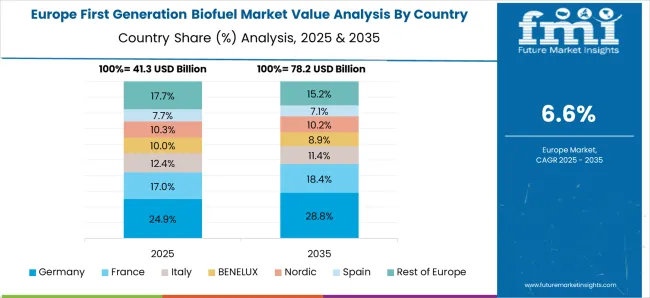
France is projected to achieve a CAGR of 7.5% during 2025–2035, supported by growing biofuel adoption in both transportation and industrial sectors. From 2020 to 2024, the market grew at a CAGR of 6.8%, driven by EU mandates and strong domestic biofuel production. The higher growth rate for 2025–2035 will be supported by the EU's continued push for cleaner energy alternatives, particularly in transportation fuels. The French market will benefit from a robust agricultural sector capable of supplying biofuel feedstocks, such as rapeseed for biodiesel. France’s strong commitment to renewable energy and carbon reduction policies will further fuel biofuel demand.
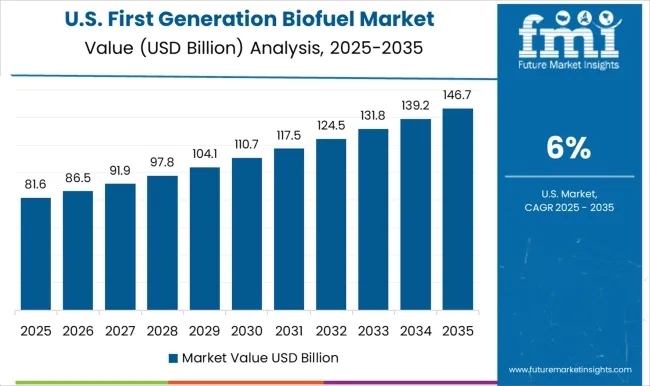
The USA is projected to grow at a CAGR of 6.0% during 2025–2035, slightly below the global average of 7.1%. From 2020 to 2024, the market grew at a CAGR of 5.3%, supported by the Renewable Fuel Standard (RFS) and government incentives for ethanol production. Higher growth in the next decade is expected as biofuel blending targets are raised, and the country continues to increase ethanol use in transportation fuels. The USA remains the largest producer of ethanol globally, and growth in the biofuels market will continue to benefit from increased demand for ethanol in the energy and transportation sectors.
The UK is expected to grow at a CAGR of 6.7% during 2025–2035, slightly below the global average of 7.1%. From 2020 to 2024, the market grew at a CAGR of 5.3%, supported by the UK's renewable energy policies and increasing demand for biofuels in transportation. The rise in ethanol consumption is a key factor, as the country strives to meet renewable energy targets and reduce fossil fuel dependence. The demand for biofuels is also supported by domestic production of bioethanol from crops such as wheat and barley. In the future, the UK will continue to prioritize biofuel production as part of its commitment to reducing carbon emissions. With stricter vehicle emission standards and increasing adoption of biofuels in the automotive sector, the market is expected to see accelerated growth during the next decade.
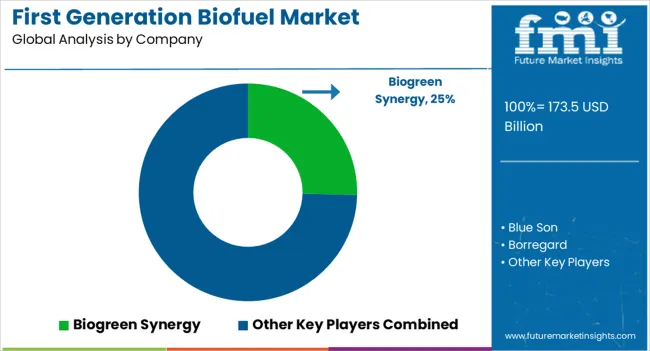
The first-generation biofuel market is shaped by competition among leading global and regional manufacturers delivering advanced biofuel solutions for transportation, energy production, and industrial use. Biogreen Synergy holds a prominent position with its comprehensive portfolio of bioethanol production, focusing on sustainable raw materials and advanced fermentation processes.
Chevron has made significant strides in biofuels through its collaboration with technology providers to enhance biodiesel production capabilities from renewable feedstocks. Neste, a leader in renewable diesel and biofuels, capitalizes on its sustainable processes for high-performance biofuels for transportation and industrial applications. Green Plains is recognized for its robust USA-based ethanol production, with innovative technology to improve production yields and reduce environmental impact. Total Energies focuses on the integration of biofuels into its global energy portfolio, leveraging its expertise in feedstock processing and biofuel blending. Competitive strategies in this market involve investing in improving feedstock efficiency, enhancing fuel quality, and developing novel biofuel production methods. Partnerships with governments and agricultural suppliers for consistent raw material sourcing are key to maintaining growth, along with the scaling of biofuel manufacturing capabilities to meet global demand. Innovations in fuel efficiency and expanded distribution networks further strengthen market presence for these key players.
| Item | Value |
|---|---|
| Quantitative Units | USD 173.5 Billion |
| Fuel Type | Biodiesel and Ethanol |
| Feedstock | Coarse Grain, Sugar Crop, Vegetable Oil, and Others |
| Application | Transportation, Aviation, and Others |
| Regions Covered | North America, Europe, Asia-Pacific, Latin America, Middle East & Africa |
| Country Covered | United States, Canada, Germany, France, United Kingdom, China, Japan, India, Brazil, South Africa |
| Key Companies Profiled | Biogreen Synergy, Blue Son, Borregard, Caterpillar, Chevron, Coasan, DuPont, Future Fuel, Green Plains, Montuk Renewables, Neste, Pacific Biodiesel, Renewable Energy Group, Total Energies, and Verbio |
| Additional Attributes | Dollar sales, market share by region, product segment, and industry application. Key drivers such as demand for innovation, regulatory factors, and consumer trends would also be crucial. |
The global first generation biofuel market is estimated to be valued at USD 173.5 billion in 2025.
The market size for the first generation biofuel market is projected to reach USD 344.6 billion by 2035.
The first generation biofuel market is expected to grow at a 7.1% CAGR between 2025 and 2035.
The key product types in first generation biofuel market are biodiesel and ethanol.
In terms of feedstock, coarse grain segment to command 44.9% share in the first generation biofuel market in 2025.






Our Research Products

The "Full Research Suite" delivers actionable market intel, deep dives on markets or technologies, so clients act faster, cut risk, and unlock growth.

The Leaderboard benchmarks and ranks top vendors, classifying them as Established Leaders, Leading Challengers, or Disruptors & Challengers.

Locates where complements amplify value and substitutes erode it, forecasting net impact by horizon

We deliver granular, decision-grade intel: market sizing, 5-year forecasts, pricing, adoption, usage, revenue, and operational KPIs—plus competitor tracking, regulation, and value chains—across 60 countries broadly.

Spot the shifts before they hit your P&L. We track inflection points, adoption curves, pricing moves, and ecosystem plays to show where demand is heading, why it is changing, and what to do next across high-growth markets and disruptive tech

Real-time reads of user behavior. We track shifting priorities, perceptions of today’s and next-gen services, and provider experience, then pace how fast tech moves from trial to adoption, blending buyer, consumer, and channel inputs with social signals (#WhySwitch, #UX).

Partner with our analyst team to build a custom report designed around your business priorities. From analysing market trends to assessing competitors or crafting bespoke datasets, we tailor insights to your needs.
Supplier Intelligence
Discovery & Profiling
Capacity & Footprint
Performance & Risk
Compliance & Governance
Commercial Readiness
Who Supplies Whom
Scorecards & Shortlists
Playbooks & Docs
Category Intelligence
Definition & Scope
Demand & Use Cases
Cost Drivers
Market Structure
Supply Chain Map
Trade & Policy
Operating Norms
Deliverables
Buyer Intelligence
Account Basics
Spend & Scope
Procurement Model
Vendor Requirements
Terms & Policies
Entry Strategy
Pain Points & Triggers
Outputs
Pricing Analysis
Benchmarks
Trends
Should-Cost
Indexation
Landed Cost
Commercial Terms
Deliverables
Brand Analysis
Positioning & Value Prop
Share & Presence
Customer Evidence
Go-to-Market
Digital & Reputation
Compliance & Trust
KPIs & Gaps
Outputs
Full Research Suite comprises of:
Market outlook & trends analysis
Interviews & case studies
Strategic recommendations
Vendor profiles & capabilities analysis
5-year forecasts
8 regions and 60+ country-level data splits
Market segment data splits
12 months of continuous data updates
DELIVERED AS:
PDF EXCEL ONLINE
First Mile Delivery Market Size and Share Forecast Outlook 2025 to 2035
First Mile Logistics Delivery Software Market Size and Share Forecast Outlook 2025 to 2035
Biofuel Testing Services Market Growth – Trends & Forecast 2018-2028
Biofuel Enzymes Market
SMT First Article Inspection Machine Market Size and Share Forecast Outlook 2025 to 2035
Next Generation Telehealth Market Size and Share Forecast Outlook 2025 to 2035
Next-generation neurofeedback device Market Size and Share Forecast Outlook 2025 to 2035
Next Generation Cancer Diagnostics Market Size and Share Forecast Outlook 2025 to 2035
Next Generation Solar Cell Market Size and Share Forecast Outlook 2025 to 2035
Next-Generation Intrusion Prevention System (NGIPS) Market Size and Share Forecast Outlook 2025 to 2035
Next Generation Computing Market Size and Share Forecast Outlook 2025 to 2035
Next-Generation Sweeteners Size and Share Forecast Outlook 2025 to 2035
Next Generation Packaging Market Analysis - Size, Share, and Forecast Outlook 2025 to 2035
Next Generation Optical Biometry Devices Market Size and Share Forecast Outlook 2025 to 2035
Next Generation Mass Spectrometer Market Size and Share Forecast Outlook 2025 to 2035
Next Generation Wireless Network Market Size and Share Forecast Outlook 2025 to 2035
Next Generation Network (NGN) Equipment Market Size and Share Forecast Outlook 2025 to 2035
Next Generation Infusion Pump Market Size and Share Forecast Outlook 2025 to 2035
Next Generation Non Volatile Memory Market Size and Share Forecast Outlook 2025 to 2035
Next Generation Molecular Assay Market – Trends & Forecast 2025 to 2035

Thank you!
You will receive an email from our Business Development Manager. Please be sure to check your SPAM/JUNK folder too.
Chat With
MaRIA